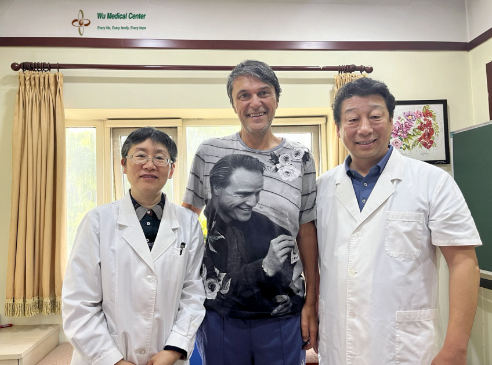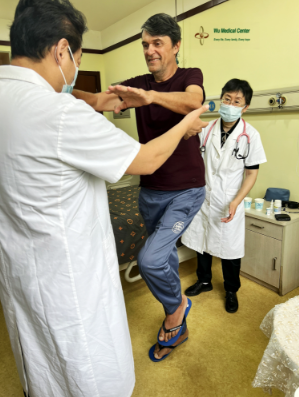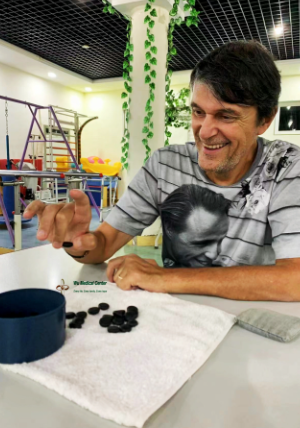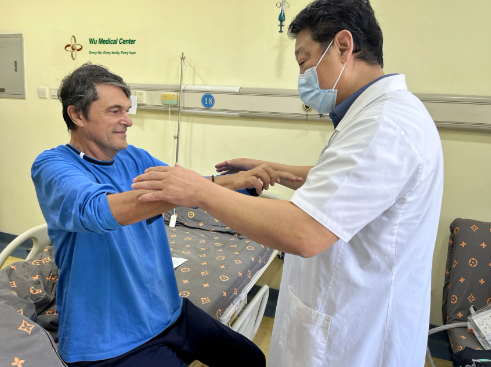Tiberiu Lucian Aldescu-Amyotrophic lateral sclerosis (ALS)-(Romania)
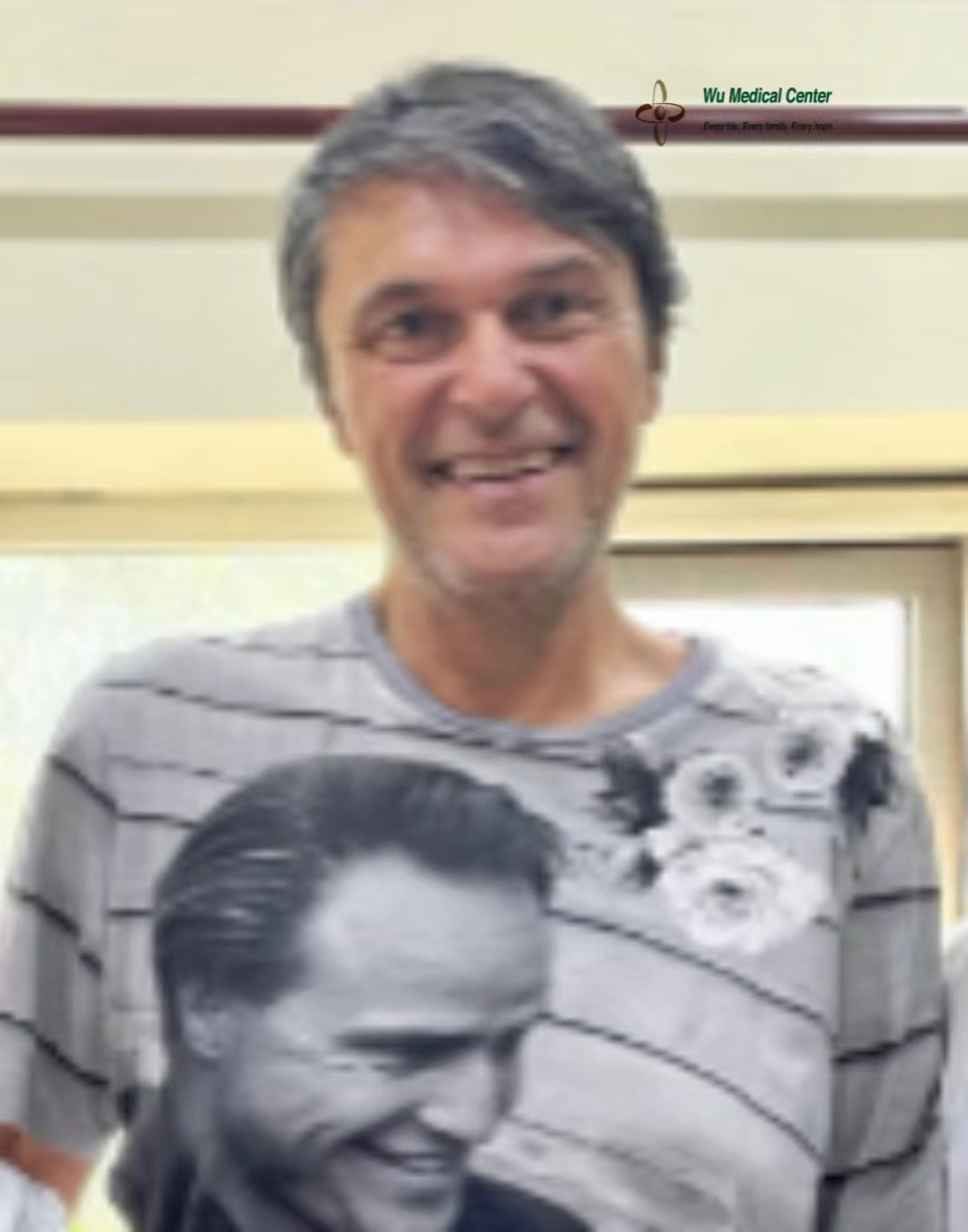 Patient name: Tiberiu Lucian Aldescu
Patient name: Tiberiu Lucian Aldescu
Gender: Male
Age: 52 years old
Nationality: Romania
Disease: Amyotrophic lateral sclerosis
Condition on admission:
The patient was admitted to hospital with amyotrophic lateral sclerosis because of progressive limb weakness, dyspnea and muscular atrophy for more than 2 years. The patient began to develop weakness of the extremities 2 years ago, with severe forearms and hands of both upper limbs, accompanied by difficulty in breathing when lying on his back. A year ago, he fell down due to poor balance and obvious muscle atrophy in his limbs. He was admitted to hospital with amyotrophic lateral sclerosis. The patient was treated with riluzole (50mg) bid to control the disease, but it was not good. He had a history of high blood pressure; he had stuffy nose and sleep apnea and was controlled by nasal spray. He had no history of other chronic diseases and infectious diseases, no history of drug and food allergies.
Admission for physical examination:
The patient’s heart rate was 87 beats per minute, breathing 18 beats per minute, and blood pressure 134/98mmHg. He was 184CM in height, 70.5kg in weight and 91% in blood oxygen. He developed normally and was moderately nutritious. There was no cyanosis on his lips. He had symmetrical chest, decreased thoracic respiratory mobility, weakened respiratory sounds in both lungs, and no dry-wet rales. His heart sound was strong and rhythmic, and there was no obvious murmur in all valvular areas of the heart. His abdomen was flat and soft, there was no tenderness and rebound pain, and the liver and spleen were not touched under the ribs. His dorsalis pedis artery fluctuated well.
Nervous system physical examination:
The patient was in a clear mind, and the spirit was fine. The articulation was clear. His ability of calculation, memory and orientation were normal. His double pupils were 3mm in diameter, sensitive to light, flexible eye movement and no nystagmus. He had symmetrical nasolabial sulcus and forehead lines on both sides, extended tongue in the middle, no atrophy of tongue muscles, strong gills, normal chewing force, strong lifting of bilateral soft palate and uvula in the middle. He turned his neck and shrugged his shoulders powerfully. His left upper limb flexor strength was grade 3, extensor muscle strength was grade 2, left hand grip strength was grade 3-, left interfinger muscle strength was grade 2-, his right upper limb flexor muscle strength was grade 3 +, extensor muscle strength was grade 2, right hand grip strength was grade 3, right interfinger muscle strength was grade 2-. His lower limb muscle strength was grade 3 +, left foot plantar flexion and dorsiflexion muscle strength was grade 2-, and right foot metatarsal flexion and dorsiflexion muscle strength was grade 2. The muscle tone of his limbs was basically normal. The muscles of his extremities and the interphalangeal muscles of his hands atrophied. The tendon reflex of his extremities was weakened. His bilateral Hoffmann sign was negative, his left Babinski sign was weakly positive, and his right Babinski sign was negative. His two-handed finger-nose test, rotation test and finger-to-finger test were clumsy; his bilateral calcaneus and tibia test was unstable. His standing balance was so poor that he couldn't stand on one leg on the left and about 1-2 seconds on the right. He couldn't stand on his toes. His meningeal irritation sign was negative.
Treatment process:
The patient’s admission diagnosis was "amyotrophic lateral sclerosis". During hospitalization, neural stem cells were given to repair motor nerve injury and mesenchymal stem cells were supported by nutrition, endocrine and immunity. Edaravone, riluzole, neurotrophic factor and other drugs were used, and combined with comprehensive rehabilitation treatment.
After treatment:
After treatment, the motor function of the patient was significantly improved, the lifting force of both arms was enhanced, the resistance was resisted by his both arms, the weight-bearing capacity was improved, the grip strength of both hands was enhanced, and the fine movement of fingers was improved. His left upper limb flexor strength was grade 4, extensor muscle strength was grade 3, left hand grip strength was grade 4, left interfinger muscle strength was grade 3 +, right upper limb flexor muscle strength was grade 4 +, extensor muscle strength was grade 3, right hand grip strength was grade 4 +, right interfinger muscle strength was grade 3 +. His lower limb muscle strength was grade 5-, left foot plantar flexion dorsiflexion muscle strength was grade 3 +, right foot metatarsal flexion dorsiflexion muscle strength was grade 4 +. The completion of his finger-nose test and rotation test was improved and the speed was accelerated. He could stand on his toes for 2-3 seconds. He could stand on one leg for 3-5 seconds. His dragging gait was relieved. His appetite improved significantly, the volume of his atrophied muscles increased, and his mental state, energy, physical fitness and sports endurance improved. His respiratory function improved, and his blood oxygen saturation averaged 94-96%.
